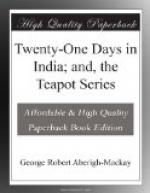[August 9, 1879.]
The tone of the A.D.C. is subdued. He stands in doorways and strokes his moustache. He nods sadly to you as you pass. He is preoccupied with—himself, [some suppose; others aver his office.] He has a motherly whisper for Secretaries and Members of Council. His way with ladies is sisterly—undemonstratively affectionate. He tows up rajas to H.E., and stands in the offing. His attitude towards rajas is one of melancholy reserve. He will perform the prescribed observances, if he cannot approve of them. Indeed, generally, he disapproves of the Indian people, though he condones their existence. For a brother in aiguillettes there is a Masonic smile and a half-embarrassed familiarity, as if found out in acting his part. But confidence is soon restored with melancholy glances around, and profane persons who may be standing about move uneasily away.
An A.D.C. should have no tastes. He is merged in “the house.” He must dance and ride admirably; he ought to shoot; he may sing and paint in water-colours, or botanise a little, and the faintest aroma of the most volatile literature will do him no harm; but he cannot be allowed preferences. If he has a weakness for very pronounced collars and shirt-cuffs in mufti, it may be connived at, provided he be honestly nothing else but the man in collars and cuffs.
When a loud, joyful, and steeplechasing Lord, in the pursuit of pleasure and distant wars, dons the golden cords for a season, the world understands that this is masquerading, skittles, and a joke. One must not confound the ideal A.D.C. with such a figure.
The A.D.C. has four distinct aspects or phases—(1) the full summer sunshine and bloom of scarlet and gold for Queen’s birthdays and high ceremonials; (2) the dark frock-coats and belts in which to canter behind his Lord in; (3) the evening tail-coat, turned down with light blue and adorned with the Imperial arms on gold buttons; (4) and, finally, the quiet disguises of private life.
It is in the sunshine glare of scarlet and gold that the A.D.C. is most awful and unapproachable; it is in this aspect that the splendour of vice-Imperialism seems to beat upon him most fiercely. The Rajas of Rajputana, the diamonds of Golconda, the gold of the Wynaad, the opium of Malwa, the cotton of the Berars, and the Stars of India seem to be typified in the richness of his attire and the conscious superiority of his demeanour. Is he not one of the four satellites of that Jupiter who swims in the highest azure fields of the highest heavens?
Frock-coated and belted, he passes into church or elsewhere behind his Lord, like an aerolite from some distant universe, trailing cloudy visions of that young lady’s Paradise of bright lights and music, champagne, mayonnaise, and “just-one-more-turn,” which is situated behind the flagstaff on the hill.




